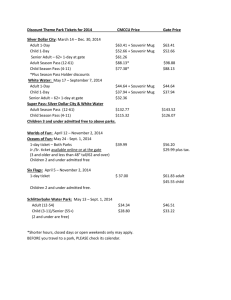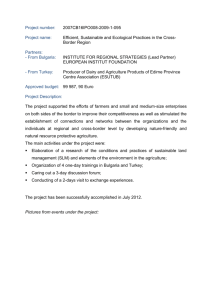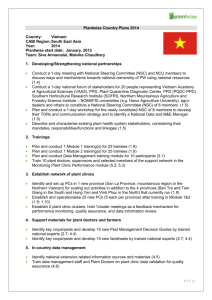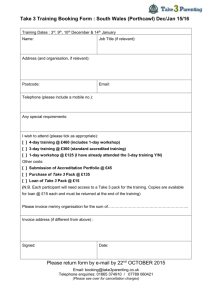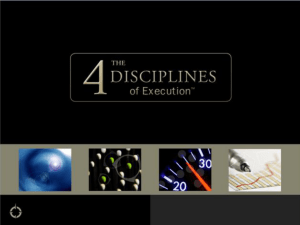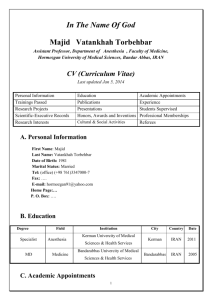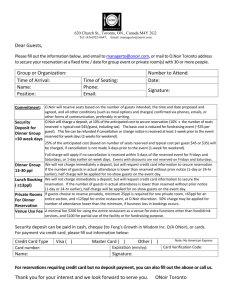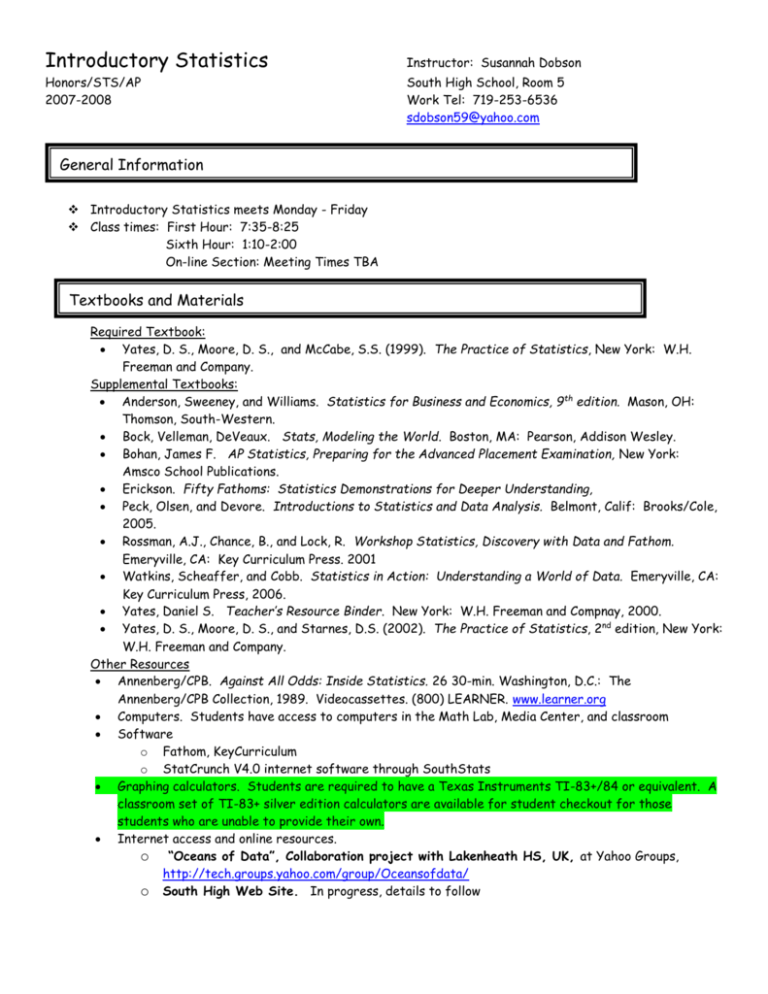
Introductory Statistics
Honors/STS/AP
2007-2008
Instructor: Susannah Dobson
South High School, Room 5
Work Tel: 719-253-6536
sdobson59@yahoo.com
General Information
Introductory Statistics meets Monday - Friday
Class times: First Hour: 7:35-8:25
Sixth Hour: 1:10-2:00
On-line Section: Meeting Times TBA
Textbooks and Materials
Required Textbook:
Yates, D. S., Moore, D. S., and McCabe, S.S. (1999). The Practice of Statistics, New York: W.H.
Freeman and Company.
Supplemental Textbooks:
Anderson, Sweeney, and Williams. Statistics for Business and Economics, 9 th edition. Mason, OH:
Thomson, South-Western.
Bock, Velleman, DeVeaux. Stats, Modeling the World. Boston, MA: Pearson, Addison Wesley.
Bohan, James F. AP Statistics, Preparing for the Advanced Placement Examination, New York:
Amsco School Publications.
Erickson. Fifty Fathoms: Statistics Demonstrations for Deeper Understanding,
Peck, Olsen, and Devore. Introductions to Statistics and Data Analysis. Belmont, Calif: Brooks/Cole,
2005.
Rossman, A.J., Chance, B., and Lock, R. Workshop Statistics, Discovery with Data and Fathom.
Emeryville, CA: Key Curriculum Press. 2001
Watkins, Scheaffer, and Cobb. Statistics in Action: Understanding a World of Data. Emeryville, CA:
Key Curriculum Press, 2006.
Yates, Daniel S. Teacher’s Resource Binder. New York: W.H. Freeman and Compnay, 2000.
Yates, D. S., Moore, D. S., and Starnes, D.S. (2002). The Practice of Statistics, 2nd edition, New York:
W.H. Freeman and Company.
Other Resources
Annenberg/CPB. Against All Odds: Inside Statistics. 26 30-min. Washington, D.C.: The
Annenberg/CPB Collection, 1989. Videocassettes. (800) LEARNER. www.learner.org
Computers. Students have access to computers in the Math Lab, Media Center, and classroom
Software
o Fathom, KeyCurriculum
o StatCrunch V4.0 internet software through SouthStats
Graphing calculators. Students are required to have a Texas Instruments TI-83+/84 or equivalent. A
classroom set of TI-83+ silver edition calculators are available for student checkout for those
students who are unable to provide their own.
Internet access and online resources.
o “Oceans of Data”, Collaboration project with Lakenheath HS, UK, at Yahoo Groups,
http://tech.groups.yahoo.com/group/Oceansofdata/
o South High Web Site. In progress, details to follow
Course Prerequisites
The prerequisite for this course is completion of Algebra II.
Attendance
Tendance
Attendance and participation is very important in this class. Students are expected to attend class
daily and participate in all classroom activities. South High attendance and tardy procedures will be
followed, please see student handbook.
Course Goals and Objectives
Tendance
The purpose of this course in statistics is to introduce students to the major concepts and tools for
collecting, analyzing, and drawing conclusions from data.
Students will be exposed to four broad concepts in statistics
Exploring Data: Observing patterns and departures from patterns (descriptive statistics: graphical,
numerical, and curve fitting for prediction of bivariate data)
Planning a Study: Deciding what and how to measure (Sampling Designs and Experimental Designs)
Anticipating Patterns: Producing models using probability and simulation (Probability models
including Normal, Binomial, and Geometric distributions)
Statistical Inference: (hypothesis testing, confidence intervals)
Students are not only expected to carry out the mathematical analysis of data, but to communicate in
writing the meaning of that analysis.
Instructional Strategies
Tendance
A variety of instructional strategies will be used in this course. They include, but are not limited to:
o Lecture
o Students Investigation (In-class Labs)
o Group Work
o Student Presentations
o Analyzing data using statistical software in the Mathematics Lab/StatsCrunch
Assessment
Tendance
Ongoing student assessment in the AP Statistics classroom is essential to ensure student success. As a
guide for instruction and monitoring student progress, multiple methods are employed. Pre- and
formative assessments are used to determine both pacing and level of understanding. This is
accomplished using Kagan cooperative learning structures, paper and pencil warm-up questions, and
student presentation of homework problems. These types of assessments will allow the instructor to
make meaningful instructional decisions to ensure all students have the opportunity for success.
Student progress for determining grades is measured using both unit tests and performance
assessments. While unit tests concentrate mainly on the current unit, questions from previous units
are included. Performance assessments for each unit allow students the opportunity to examine a topic
in greater detail and use the topic in a “case study” type situation. Communication is an essential piece
of the performance assessments. These assignments provide students with an opportunity to use their
statistical knowledge in a meaningful way. Long term projects give students the opportunity to draw
connections between all aspects of the statistical process, including design, analysis and conclusions.
Both written and oral communication of these projects is expected. In all of these methods of
assessment students are required to use the language of statistics to communicate about the methods
utilized, the analysis, and the results.
Students will have an opportunity to display mastery of the concepts in this course in several different
ways.
Written homework, collected and graded for accuracy (homework will not be accepted
for any chapter after the test for that chapter is given)
Daily warm-up exercises
Chapter Tests
Cumulative Final Exam (Worth two chapter exams)
Final Project (Students will work alone or with a partner to choose a topic of interest,
formulate a research question, gather the data, analyze the data, and present the
research in a classroom presentation and a written report.
Letter grades are based on an honors scale and are as follows:
93% - 100%
A
86% - 92%
B
77% - 85%
C
70% - 76%
D
Below 70%
F
Schedule of Topics
Tendance
Note: The following timeline is approximate and is subject to change depending on the needs of the
students. Exam dates will be announced in class and posted in the classroom.
I: Exploratory Data Analysis
Chapter 1—Exploring Data
YMM Sect.
AP Course
Description/
Topic
Introduction
Timeline
4-days
Video
1-day
1.1
2-days
I:
A-1,2,3,4
E-1
Content
Curricular Requirements:
[C2a] [C3] [C4] [C5]
Introductory Activity—Westvaco activity. Working in small
groups, students explore a “real-world” age
discrimination case. Included in the discussion topics:
*graphical displays
*numerical descriptions
*simulation techniques
*probability
*inference
Classroom discussion will also include how a statistics
classroom is different from a traditional
mathematics classroom, with emphasis on statistical
thinking and the importance of
communication.
Against All Odds-Video #2 “Picturing Distributions”
Graphical and Tabular Displays of Data including:
Quantitative Data Displays
*Dotplots
*Histograms
*Stemplots
*Timeplots
*Cumulative Frequency Plots
Assignment
*Classroom activities,
including constructing
dotplots, completing
simulation, calculating
numerical descriptions
and probabilities.
*Written group interpretation of
simulation results with
justification to be
presented to class
*Note-taking guide for video
*Read Sect. 1.1 Pg 4-25
*HW-1.1
*Begin Chapter 1
Performance
Video
1-day
1.2
I:
B-1,2,3,4,5
2-days
Making
Connections
I:
A-1,2,3,4
B-1,2,3,4,5
C-1,2,3,4
2-days
Review
1-day
Test
1-day
*Using S(shape) O (outlier,cluster,gaps) C(center)
S(spread) to describe distn
Categorical Data Displays
*Bar Graphs
*Pie Graphs
Against All Odds- Video #3 “Describing Distributions”
*Describing distn using appropriate Measures of center:
mean, median, mode
*Measures of spread: standard deviation, IQR, range
*5-number summary
*Finding outliers numerically
*Unit changes
*Skills: Summary stats on the TI
*Using appropriate graphical and numerical methods to
describe and compare distribution(s) using:
S (shape) O (outliers,clusters,gaps) C (center)
S
(spread)
*Students will complete problems, grade using rubrics,
revise if necessary and present solutions.
Note: An emphasis on communication will be stressed in the
Free Response questions
Review for test using practice multiple choice and free
response questions
Chapter 1 test:
Multiple Choice
Free Response
Assessment (See
Appendix #1)
*Note-taking guide for video
*Read Sect 1.2 pg 30-51
*HW- 1.2a
*AP Free Response Problems
1997 #1
2000 #3
2001 #1
2002B #5
2005B #1 2003 #1a,b 2004 #1
2004B #5a 2005 #1a 2006 #1
*Study for exam
*Finish Chapter 1
Performance
Assessment
*Read Pgs 66-77
III: Anticipating Patterns
Chapter 2—The Normal Distribution
YMM Sect.
AP Course
Description/
Topic
Density Curve
Activity
Timeline
2.1
2-days
1-day
III: C-1
2.2
III: C-1,2,3
3-days
Content
Curricular Requirements:
[C2c] [C4] [C5]
YMM class activity 2B-Roll a Normal Distribution— combine
data from each group to create a class
histogram. Discuss
how a mathematical model
(density curve) is used to
describe distns
*Discuss characteristics of density curves.
*Discuss relationship between the shape of the curve,
mean and median
*Using Geometry and the Empirical Distn (68-95-99.7
Rule) to find area
*Using the empirical distn for percentiles
*Standard Normal Curve—transforming normal distn onto a
standard normal curve N(0,1)
*Normal Distn Calculations—finding the percent of
observations below, above, and between values
and interpreting in context—using normal distn
table
*Using Table A to find the
corresponding value in a
distn for area below,
above, and between
*Assessing normality for a distn using a normal
probability
plot
*Skill: Using TI83/84 to answer normal probability questions
Assignment
*View Against All Odds- Video
#4-Normal Distn and complete
video guide
*HW-2.1
*Read Pgs 83-97
*View Against All OddsVideo #5-Normal Calc.
Complete video guide
*HW-2.2
*Begin performance
assessment #2
Making
Connections
2-days
Using AP Free Response questions, use the methods of
this chapter to analyze distn and practice
communicating information. Students will complete
assigned problems, grade using
rubrics, and present
solutions
Review
1-day
Note: An emphasis on communication will be stressed in the
Free Response questions
Review Unit 2
Exam
1-day
Unit 2 exam utilizing both MC and FR questions
*AP Free Response Problems
2002 #3a
2003 #3a,b
2004B #3a,b 2005B #6b
2006 #3a
2006B #3a
*Study for exam
*Finish Perf. Assess. #2
*Read pgs 107-122
I: Exploratory Data Analysis
Chapter 3—Examining Relationships
YMM Sect.
AP Course
Description/
Topic
Data
Collection
3.1
Timeline
1-day
1-day
I:D-1
3.2
1-day
I: D-2
3.3
3-days
I:
D-2,3,4
Making
Connections
2-days
Content
Curricular Requirements:
[C2a] [C3] [C4] [C5]
*Collect data for Performance Assessment #3---“BungeeJumpin Barbie”
Activity includes students describing the
procedure used to gather data, analysis of
data, and conclusions based on the
experiment.
Scatterplots
*Constructing and interpreting scatterplots (response
variable vs explanatory variable
*Describe relationships utilizing Strenth, Type,
Direction
*Recognizing outliers
*Skill: Construction of scatterplots on the TI-83/84
Correlation
*Properties of correlation
*What affects correlation
*Calculating correlation
Activity: “guess the correlation”—java applet
Least-squares Regression
*Interpreting slope and y-intercept in context
*Least-squares principle
Fathom activity: minimizing SSE
*Calculating the LSRL from
--summary stats
--raw data (TI-83/84, Fathom, StatCrunch)
--Reading computer output (Fathom,
StatCrunch, Minitab)
*Effects of outliers and influential points on LSRL
*Residuals and residual plots—interpretation and calculation
on the TI-83/84
*Coefficient of determination—calculation and
interpretation
*Skills: Using computer output to create and
interpret
LSRL
Using AP Free Response questions, students will
complete
the problems, grade using AP rubrics,
revise if necessary
and present solutions.
Note: An emphasis on communication will be stressed in the
Assignment
*Begin Performance
Assessment (PA) #3
*Against All Odds Video #8Describing Relationships
*AAO-Video Guide
*HW –3.1
*Read Pgs 128 – 135
*Against All Odds-Video #9
- Correlation
*AAO-Video Guide
*HW—3.2
*Read Pgs 137 – 160
*HW—3.3
*AP Free Response
1998 #2
1998 #4
1999 #1
2000 #1
2002 #4
2002B #1
2003B #1
2005 #3
2005B #5
2006 #2
Free Response questions
2006B #1
Review
1-day
Review Unit 3 - analyzing bivariate data
*Study for exam
Exam
1-day
Unit 3-analyzing bivariate data exam –MC and FR
*Finish PA #3
*Read Pgs 176-197
I: Exploratory Data Analysis
Unit 4—More Bivariate Data
YMM Sect.
AP Course
Description/
Topic
Data
Collection
Timeline
1-day
4.1
3-days
4.2
1-days
I:
D-4
II:
B-3
C-3
D
4.3
I:
E-1,2,3,4,5
2-days
Content
Curricular Requirements:
[C2a] [C4] [C5]
*Collect data for Performance Assessment #4---“Spaghetti and
Skittles”
*Re-expressing data to achieve linearity
Using logarithms
Using the LSRL of the transformed data to
find both power and exponential models
*Power and Exponential Models using technology
Power and Exponential models on TI-83/84,
StatsCrunch, Fathom
*Determining the “best” model
*Lurking Variables
*Common Response
*Confounding
*Causation
Making
Connections
1-day
Review
1-day
Exploring Categorical Data
*Frequency tables and bar charts
*Marginal and Conditional Distributions
*Using relative frequency charts to look at association
between variables
*Simpson’s Paradox
*Using AP Free Response and AP-like questions,
students will
complete the problems, grade using
AP rubrics,
revise if necessary and present
solutions.
Note: An emphasis on communication will be stressed in the
Free Response questions
Review for Unit 4 Exam
Exam
1-day
Unit 4- Exam –MC and FR
Assignment
*Against All Odds Video #7
*AAO-Video Guide
*Begin PA #4
*HW 4.1
*HW 4.2
*HW 4.3
*Against All Odds Video #12
– Experimental Design
*AAO-Video Guide
*AP Free Response
1997 #6
2003B #2a,b
2004B #1
*Supplemental problems from
AP Practice Books
*Study for exam
II: Sampling and Experimentation
Unit 5 – Producing Data
YMM Sect.
AP Course
Description/
Topic
Timeline
Content
Curricular Requirements:
[C2b] [C3] [C4] [C5]
Assignment
Sampling
Activity
1-day
5.1
II:
A-1,2,3,4
B-1,2,3,4
D
2-days
5.2
II:
C-1,2,3,4,5
3-days
5.3
2-days
Making
Connections
1-day
III:
A-5
Activity: Random Rectangles
Students will produce data to evaluate as each
type of sampling method is discussed
*Observational Studies vs Experiments
*Census vs Sample
*Surveys
-Construction of and sources of bias
Question Wording
Administration of
*Sampling Methods
Probability Samples including: Simple Random
Sample, Stratified Random Sample, Cluster Sampling
Systematic Sample, Multi-stage Sample.
Non-probability Samples including: Voluntary
Response, Convenience Sampling
*Skill: Using Technology (Random Digits Table & TI83/84) to choose samples
*Sample Surveys---Polls
Bias: Undercoverage, nonresponse, response bias
question
wording
*Generalizing to a population
*Experimental Design
Principles of Experimental Design: control,
random assignment, replication
Placebo Effect, blinding, double blinding
*Completely randomized design, Block design, matched
pairs, cross-over design
*Activity: Pulse---sitting vs standing
Simulating Experiments-Five-step process
1. State problem or experiment
2. State assumption
3. Assign digits to outcomes
4. Simulate
5. State conclusions
*Skill: Using the TI-83/84 to generate random digits for
simulations
*Using AP Free Response and AP-like questions, students will
complete the problems, grade using AP rubrics,
revise if necessary and present solutions.
Note: An emphasis on communication will be stressed in the
Free Response questions
*Against All Odds Video #14
– Samples and Surveys
*AAO-Video Guide
*HW 5.1
*Begin 1st semester project:
(Survey Project)
*Against All Odds Video #13
– Blocking and Sampling
*AAO-Video Guide
*HW 5.2
*HW 5.3
*AP Free Resp.-Chosen from:
1997 #2
1998 #3a,b
1998 #6
1999 #3
2000 #5
2001 #3
2001 #4
2002 #2
2002B #3
2003 #4
2003B #4
2004 #2
2004B #2
2005#1b,c
2005 #5a,c
2005B #3
2006 #5
2006B #5
*Study for Exam
Exam
Review
1-day
Review for Unit 5 Exam
Exam
1-day
Unit 5- Exam –MC and FR
*Finish 1st semester project
Survey Project
Survey
Projects
2-days
Students will present survey projects
*Against All Odds #15
What is Probability
AAO-Video Guide
III: Anticipating Patterns
Unit 6 – Probability
(Combined with Unit 7)
YMM Sect.
AP Course
Description/
Topic
6.1
III:
A-1,2
Timeline
1-day
6.2
2-days
6.3
3-days
III:
A-3
III:
A-3
B-1
Making
Connections
Exam
Content
Curricular Requirements:
[C2c]
Activity: Spinners and Dice
Classroom discussion from activity for probability basics:
probability as relative frequency in the long run, outcomes,
events, sample space
Probability Models
Multiplication Principle
Basic Probability Rules using:
Tree Diagrams
Venn Diagrams
Contingency Tables
More Probability
Conditional Probability
Independence:
Activity: Abby’s Kennels
Using tree diagrams to “Reverse the Condition”
Assignment
*HW 6.1
*Begin practice packet for
final exam
*HW 6.2
*HW 6.3
*Making connections for Unit 6 combined with Unit 7
*Against All Odds #16
Random Variables
AAO-Video Guide
*Note: Exam for Unit 6 combined with Unit 7
-------------------------------
III: Anticipating Patterns
Unit 7 – Random Variables
(Combined with Unit 6)
YMM Sect.
AP Course
Description/
Topic
7.1
III:
A-4
7.2
III:
A-4,6
B-2
Making
Connections
Timeline
2-days
3-days
2-days
Content
Curricular Requirements:
[C2c] [C4]
Random Variable Basics
Discrete vs Continuous
Validity of Probability Distn
Means and Variances for discrete random variables
Law of Large Numbers
Rules for combining random variables
Activities: Roll the Dice, Rats in a Maze
*Using AP Free Response and AP-like questions, students will
complete the problems, grade using AP rubrics,
revise if necessary and present solutions.
Note: An emphasis on communication will be stressed in the
Free Response questions
Exam
Review
1-day
Review for Units 6&7 exam
Exam
1-day
Exam on Units 6 & 7
Assignment
*HW 7.1
*HW 7.2
*AP Free Resp.—Chosen From:
1997: #3 2002: #3
1998: #6 2002B: #2
1999: #4 2003: #3a,b
1999: #5 2003B: #2
2000: #6b,c
2003B: #5a,b
2001: #2 2004: #4
*Study for Exam
*Work on Review Packet for
final
Performance
Assessment
2-days
Final
Review
1-day
First
Semester
Final Exam
1-day
Students will work with a partner to work through a Casino Lab
calculating probabilities experimentally, using simulations, and
theoretical
Students will present problems from review packet for semester
final
*Finish Review Packet for
Semester Final
*Study for Final
Students will demonstrate understanding of the topics covered in
Units 1-7 by completing a final exam consisting of Multiple
Choice/Free Response questions
III: Anticipating Patterns
Unit 8 – Binomial and Geometric Distributions
YMM Sect.
AP Course
Description/
Topic
IntroActivity
Timeline
Content
8.1
3-days
8.2
2-days
Making
Connections
2-days
Exam
Review
1-day
Curricular Requirements:
[C2c] [C3] [C4] [C5]
Activity: Cereal and Tiger Woods: Students will collect data
with a hands-on activity for two questions (one binomial/one
geometric)
Binomial Distributions
Conditions (FITS)
Simulating Binomial Settings
Calculating Probabilities
Expected Value--Mean and Standard Deviation for a
binomial distn
Normal approximation to binomial
Skill: Calculator computations for Binomial distn
Geometric Distributions
Conditions (WITS)
Simulating Geometric Settings
Calculating Probabilities
Expected Value--Mean for a Geometric Distn
Skill: Calculator computations Geometric Distn
*Using AP Free Response and AP-like questions,
students
will
complete the problems, grade using
AP rubrics,
revise if necessary and present
solutions.
Note: An emphasis on communication will be stressed in the
Free Response questions
Review for Exam on Unit 8
Exam
1-day
Unit 8 Exam
1-day
III:
A-4
III:
A-4
Assignment
*Against All Odds #17
Binomial Distributions
AAO-Video Guide
*HW 8.1
*Begin PA for Unit 8
*HW 8.2
*Free Resp.—Chosen From
2003: #3c
2004: #3a
*Supplemental problems from
AP Review books
*Study for exam
*Finish PA for Unit 8
III: Anticipating Patterns
Unit 9 – Sampling Distributions
YMM Sect.
AP Course
Description/
Topic
9.1
III:
D-6
Timeline
2-day
Content
Curricular Requirement
[C2c] [C4] [C5]
Activity: The Distribution of Height
Students will create a post-it sampling distribution of
women’s heights using their calculator’s normal distn. This
distn will form the basis of class discussion.
Parameter vs Statistic
Sampling Variability
Assignment
*HW 9.1
*Begin PA for Sampling Distn
Describing Sampling Distn using SOCS
Bias/Variability
9.2
III:
D-1,4,6
2-days
Making
Connections
2-days
Exam
Review
1-day
Activity: The color of Reeses Pieces
Collect data on the proportion of Orange Reeses Pieces
Create the sampling distn for proportions
Mean and Standard Deviation of the sampling distn
Conditions for using sampling distn
Sampling Distn of the difference in proportions
Connections to inference
Activity: The Age of Pennies
Collect data on the “average” age of pennies from both a
uniform distn and a right-skewed distn of pennies
Create the sampling distn of x-bar
Conditions for using sampling distn
Central Limit theorem
Law of Large Numbers
Sampling Distn for difference in means
Connections to inference
Computer Activity: Java activity for sampling distn, CLT
*Using AP Free Response and AP-like questions, students will
complete the problems, grade using AP rubrics,
revise if necessary and present solutions.
Note: An emphasis on communication will be stressed in the
Free Response questions
Review for Unit 9 exam
9.3
2-days
Exam
1-day
Unit 9 Exam
III:
D-2,3,5,6
*HW 9.2
*Finish PA for Chapter 9
*Against All Odds #18
AAO-Video Guide
*HW 9.3
*Free Resp—Chosen From
1998: #1
2004B: #3c,d
*Supplemental problems from
AP Review books
*Study for exam
IV: Statistical Inference
Unit 10-Introduction to Inference
YMM Sect.
AP Course
Description/
Topic
Intro
10.1
Timeline
1-day
2-days
IV:
A-1,2,3
10.2
3-days
10.3
1-day
IV:
B-1
Content
Curricular Requirements:
[C2d] [C3] [C4] [C5]
Activity: Pick a Card
Introduction to Inference
M&M activity to estimate the proportion of blue
candies
*Point Estimate
*Margin of Error
*Concept of “95% confidence”
*Logic behind creating confidence interval
*Pieces of the interval that affect our estimate
*Connection of confidence intervals for
proportions to sampling distributions
Calculator CI activity
Survivor
Activity:Blood pressure activity?? Does our class differ?
*Outline of a significance test
*The null and alternative hypothesis
*Choosing a procedure/verifying conditions
*Test Statistic/P-value
*Decision/Conclusion
Statistical Significance/Practical significance
Hawthorne Effect
Assignment
*Begin PA for Chapter 10
*Against All Odds - #19
Confidence Intervals
AAO-Video Guide
*Against All Odds - #20
Significance Tests
AAO-Video Guide
*HW 10.2
10.4
3-days
Making
Connections
2-days
IV:
B-1
EXAM
Note
Type I and Type II Errors:
Activity: Simulation to demonstrate that Type I error does
in fact happen at our significance level
Power:
Activity: Simulations to demonstrate what affects the
power of a test
*Using AP Free Response and AP-like questions, students will
complete the problems, grade using AP rubrics,
revise if necessary and present solutions.
*HW 10.4
*Free Resp.---Chosen From:
1997: #4 2003B: #3
2002: #1 2003B: #4c,d
2002: #5 2003B: #6b,c
2003: #1c
2004B: #5b,c
2003: #2
*Finish PA Unit 10
Exam for Unit 10 to be combined with Unit 11
IV: Statistical Inference
Unit 11-Inference for Means
YMM Sect.
AP Course
Description/
Topic
11.1
Timeline
3-days
III:
D-7
IV:
A-6,7
B-4,5
11.2
3-days
Making
Connections
3-days
IV:
A-7
B-5
Content
Curricular Requirements:
[C2d] [C3] [C4] [C5]
*Hypothesis Tests and Confidence intervals for means
-t-distribution
-standard error
-degrees of freedom
-robustness of a test
-Construct and interpret a 1-sample confidence
interval
-Conduct and interpret a 1-sample t-test for
means
-t-procedures for matched pair data
-Skills: HT & CI on the TI-Calculator
-Skills: HT & CI from computer output
*Hypothesis Test and Confidence intervals for two means.
(Independent Samples)
-Complete steps for HT & CI
-Interpret the results
-Skills: HT & CI on the TI
-Skills: HT & CI from computer output
*Using AP Free Response and AP-like questions, students will
complete the problems, grade using AP rubrics,
revise if necessary and present solutions.
Exam Review
1-day
Note: An emphasis on communication will be stressed in the
Free Response questions
Review for Units 10 & 11 Exam
Exam
1-day
Exam for Units 10 & 11
Assignment
*Against All Odds #21
AAO-Video Guide
*HW 11.1
*Begin PA Unit 11
*HW 11.2
*Against All Odds #22
AAO-Video Guide
Free Resp.—Chosen From:
1997: #5 2001: #5
1999: #6 2002B: #6a
2000: #2 2004: #6
2000: #4 2004B: #4
Study for Exam
Finish PA for Unit 11
IV: Statistical Inference
Unit 12-Inference for Proportions
YMM Sect.
AP Course
Description/
Topic
Intro
Timeline
1-days
12.1
2-days
12.2
2-days
Making
Connections
2-days
IV:
A-4
B-2
IV:
A-5
B-3
Content
Assignment
Curricular Requirements:
[C2d] [C3] [C4] [C5]
Activity: Is One Side of a Coin Heavier
Data Collection for inference for proportions
*Hypothesis Testing and Confidence Intervals for a single
proportion
-construct and interpret CI for 1-proportion
-perform and interpret HT for 1-proportion
-Skills: HT & CI on the TI
-Skills: HT & CI from computer output
*Hypothesis Testing and Confidence Intervals comparing two
proportions
-construct and interpret CI for the
difference of two proportions
-perform and interpret HT for the difference
of
two proportions
-Skills: HT & CI on the TI
-Skills: HT & CI from computer output
*Using AP Free Response and AP-like questions, students will
complete the problems, grade using AP rubrics,
revise if necessary and present solutions.
Exam Review
1-day
Note: An emphasis on communication will be stressed in the
Free Response questions
Review for Unit 12 exam
Exam
1-day
Unit 12 exam
*Against All Odds #23
AAO-Video Guide
*Begin PA Unit 12
*HW 12.1
*HW 12.2
Free Resp.---Chosen From:
1997: #4 2003: #6
1998: #5 2003B: #3
2000: #6a
2003B: #6a
2002: #6 2004B: #6
2002B: #4
Review for test
Finish Unit 12 PA
IV: Statistical Inference
Unit 13-Inference for Distributions
Chi-Squared
YMM Sect.
AP Course
Description/
Topic
13.1
III:
D-8
13.2
IV:
B-6
Timeline
2-days
3-days
Content
Curricular Requirements:
[C2d] [C3] [C4] [C5]
Activity: “I didn’t get enough blue m&m’s”
*Chi-squared distribution—features of….
*Chi-squared Goodness of Fit
-perform and interpret “Goodness of Fit” HT
for the differences in more
than two
proportions.
-Skills: Goodness of Fit on TI
-Skills: Goodness of Fit from computer output
Inference for two-way tables
*Chi-squared test for independence and
homogeneity of populations
-recognizing the difference between a test of
independence and homogeneity of
populations
-perform and interpret HT for independence
Assignment
*Against All Odds #24
AAO-Video Guide
*Begin Unit 13 -14 PA
*HW 13.1
*HW 13.2
and homogeneity
Making
Connections
2-days
*Using AP Free Response and AP-like questions, students will
complete the problems, grade using AP rubrics,
revise if necessary and present solutions.
Note: An emphasis on communication will be stressed in the
Free Response questions
Exam for Unit 13 combined with Unit 14
Note
Free Resp—Chosen From:
1999: #2
2002B: #6b,c
2003: #5
2003B: #5c
2004: #5
IV: Statistical Inference
Unit 14-Inference for Regression
YMM Sect.
AP Course
Description/
Topic
14.1
Timeline
Content
Making
Connections
2-days
Exam Review
1-day
Curricular Requirements:
[C2d] [C3] [C4] [C5]
Inference for Regression:
*Hypothesis testing and Confidence intervals for
the model
-Construct and interpret CI for the slope of
the regression line
-Perform and interpret HT for the slope of
the regression line
-Skills: HT & CI on the TI
-Skills: HT & CI from computer output
*Using AP Free Response and AP-like questions, students will
complete the problems, grade using AP rubrics,
revise if necessary and present solutions.
Note: An emphasis on communication will be stressed in the
Free Response questions
Review for Unit 13 & 14 exam
Exam
1-day
Unit 13 & 14 exam
2-days
IV:
A-8
B-7s
Assignment
*HW 14.1
*Free Resp.—Chosen From:
2001: #6
2007: #6
*Supplemental problems from
AP Review books
Study for exam
Finish Unit 13& 14 PA
Review for the AP® Exam
YMM Sect.
AP Course
Description/
Topic
Review
Timeline
12-days
Content
Curricular Requirements:
[C2a] [C2b] [C2c] [C2d] [C3] [C4] [C5]
*Review for AP exam including both multiple choice and free
response problem
*Practice with rubrics grading Free Response problems
*Practice AP exam---MC and FR (2nd semester final)
Assignment
*MC and Free Response from
prior AP Exams and
supplemental AP
Review books
After the Exam
YMM Sect.
AP Course
Description/
Topic
Semester
Project
Timeline
Concurrent
With
Content
Curricular Requirements:
[C2a] [C2b] [C2c] [C2d] [C3] [C4] [C5]
*Students will begin 2nd semester project during Exam review
-Choosing a partner
Assignment
*2nd Semester project
Review
After
The
Exam
7-days
After
The Exam
3-days
-Choosing a Topic
-Writing the Research Question
*Students will use class time to:
-design the study
-gather data
-analyze the data
-write report
-develop powerpoint presentation
*Analysis of Variance Activity
*Student presentations of semester projects
Extra Help and Contact Information
Tendance
School Phone: 253-6536
Home Phone: 544-2972 (Before 9:00pm please)
I am available for extra help daily:
7th Hour 2:05 – 2:55
After School by Appointment
Email: sdobson59@yahoo.com
*2nd Semester project

